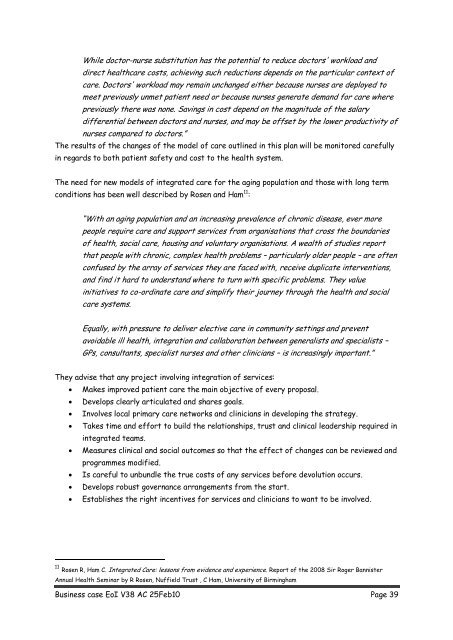Better Sooner More Convenient Primary Care - New Zealand Doctor
Better Sooner More Convenient Primary Care - New Zealand Doctor
Better Sooner More Convenient Primary Care - New Zealand Doctor
Create successful ePaper yourself
Turn your PDF publications into a flip-book with our unique Google optimized e-Paper software.
While doctor-nurse substitution has the potential to reduce doctors' workload and<br />
direct healthcare costs, achieving such reductions depends on the particular context of<br />
care. <strong>Doctor</strong>s' workload may remain unchanged either because nurses are deployed to<br />
meet previously unmet patient need or because nurses generate demand for care where<br />
previously there was none. Savings in cost depend on the magnitude of the salary<br />
differential between doctors and nurses, and may be offset by the lower productivity of<br />
nurses compared to doctors.”<br />
The results of the changes of the model of care outlined in this plan will be monitored carefully<br />
in regards to both patient safety and cost to the health system.<br />
The need for new models of integrated care for the aging population and those with long term<br />
conditions has been well described by Rosen and Ham 11 :<br />
“With an aging population and an increasing prevalence of chronic disease, ever more<br />
people require care and support services from organisations that cross the boundaries<br />
of health, social care, housing and voluntary organisations. A wealth of studies report<br />
that people with chronic, complex health problems – particularly older people – are often<br />
confused by the array of services they are faced with, receive duplicate interventions,<br />
and find it hard to understand where to turn with specific problems. They value<br />
initiatives to co-ordinate care and simplify their journey through the health and social<br />
care systems.<br />
Equally, with pressure to deliver elective care in community settings and prevent<br />
avoidable ill health, integration and collaboration between generalists and specialists –<br />
GPs, consultants, specialist nurses and other clinicians – is increasingly important.”<br />
They advise that any project involving integration of services:<br />
Makes improved patient care the main objective of every proposal.<br />
Develops clearly articulated and shares goals.<br />
Involves local primary care networks and clinicians in developing the strategy.<br />
Takes time and effort to build the relationships, trust and clinical leadership required in<br />
integrated teams.<br />
Measures clinical and social outcomes so that the effect of changes can be reviewed and<br />
programmes modified.<br />
Is careful to unbundle the true costs of any services before devolution occurs.<br />
Develops robust governance arrangements from the start.<br />
Establishes the right incentives for services and clinicians to want to be involved.<br />
11 Rosen R, Ham C. Integrated <strong>Care</strong>: lessons from evidence and experience. Report of the 2008 Sir Roger Bannister<br />
Annual Health Seminar by R Rosen, Nuffield Trust , C Ham, University of Birmingham<br />
Business case EoI V38 AC 25Feb10 Page 39

















